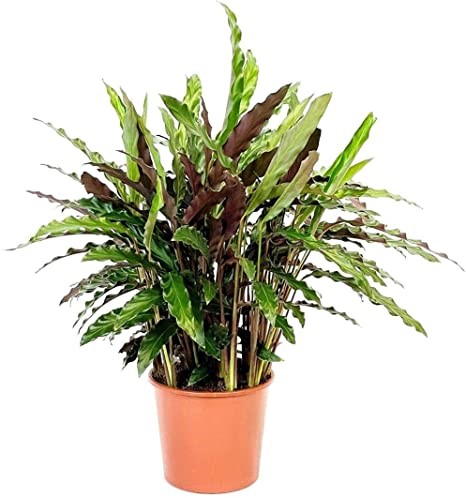Calathea Rufibarba is one of the rare plants with unusual leaf shapes. It is attractive enough to grab the visitors’ attention and tends to improve the visualization of your garden bed.
The fantastic thing about Calathea Rufibarba is that it has long green leaves with maroon undersides. Calathea Rufibarba is one of the easiest plants to care for, and you will never regret growing it.
The unique pattern of the leaves and mesmerizing foliage will satisfy your needs. Calathea Rufibarba is furry due to its wavy pattern. The wavy pattern and the thin and elongated leaves structure make the plant a perfect choice of yours.
The combination of the green and maroon color of the leaves makes it a unique choice, due to which you can also use the plant for ornamental purposes.

Calathea Rufibarba is a unique plant compared to the other varieties due to its pattern, and it is native to Brazil.
This marvelous plant to grow at your place and enjoy its appealing beauty. Here is a guide that will help you out to grow Calathea Rufibarba.
What are the shared names of Calathea Rufibarba?
Calathea Rufibarba gives different unique names due to the ideal structure of its leaves and stems.
- Velvet Calathea
- Furry feather Calathea
- Furry Calathea
What are Calathea Rufibarba’s Care Requirements?
Calatheas are tropical plants, and they love to grow in the same conditions. The fantastic thing about Calathea Rufibarba is that they are not prone to diseases and resistant to pests.
So, you do not have to worry much about the pests attack. Just make your plant happy by providing enough humidity, water, and sunlight.
Maintaining these plants will keep your plant happy, and your furry feather Calathea will thank you for this by showing beautiful growth.
Let us have a look at the care requirements of Calathea Rufibarba:
1. Fertilizer preferences:
Calathea Rufibarba is sensitive to overfertilizing do you need to follow an optimum timeframe to fertilize it.
The plant only needs fertilizer in the growing season, and fertilizing is highly restricted in autumn or winter.
Pro tip:
In the spring or summer season, use a liquid fertilizer with high contents of nitrogen. It will encourage healthy and fast growth.
2. Humidity preferences:
Calathea Rufibarba cannot grow well in a low humidity environment as they are native to tropical regions with higher humidity levels.
Also Check: Complete Calathea Fasciata Plant Care & Propagation Tips
How to maintain Humidity Level for Calathea Rufibarba?
Here are some of the tips that can help you in maintaining the humidity level:
- Use a humidifier and set it near the plant.
- Place Calathea Rufibarba will other plants.
- Use a pebble tray or use misting strategy to water your plant.
Do not over humidify the environment as it can promote diseases and exposure to fungal diseases.
3. Light preferences:
Duplicate tropical environment conditions at your place and see the magic! Your plant will grow significantly in these conditions. A shaded and humid environment is a perfect choice to grow your Calathea Rufibarba.
Do not place Calathea Rufibarba in direct sunlight as it can damage the foliage resulting in yellowing of the leaves.
Pro tip:
You must not place your Calathea Rufibarba near your window as provide it with a space. Direct exposure to the sun will not work well.
4. Repotting preferences:
Calathea Rufibarba shows a slow-growing rate, due to which it does not require frequent repotting. But if you feel like your plant needs a large pot to grow, then go for it.
Repotting is recommended in the spring or summer season, and you must choose a bigger pot to repot your Calathea Rufibarba.
5. Soil preferences:
The perfect soil that you can choose to grow your Calathea Rufibarba is the well-draining mix. It would be best if you chose the right potting mix to make your plant happy. A soil full of organic mix will do the wonder in growing your plant.
Ensure that the soil is well-draining, as excess water in the pot can result in causing root rot or fungal attack. Like compact soil can resist your plant’s growth, and the clay present in it will not let the plant drain out.

What is the Perfect soil to grow Calathea Rufibarba?
You need to choose the right soil to grow fast. Water-retaining and well-draining soil are highly essential to make your Calathea Rufibarba happy.
The ideal potting mix that you can prepare to grow Calathea Rufibarba is to mix equal parts of the following ingredients:
- Potting soil
- Compost
- Coconut coir
- Vermiculite/ pearlite
The reason for choosing this mix is that the ingredients will help retain water and give enough space for the excessive water to drain.
6. Temperature preferences:
Calathea Rufibarba enjoys temperatures from 18 to 23 degrees Celsius, and mark this thing in your mind that it cannot bear temperature below 15 degrees.
A low-temperature environment can damage the leaves resulting in stunted growth. So, provide these Calathea Rufibarba with a tropical environment and do not compromise with its happiness.
7. Watering preferences:
One of the primary requirements is to let your plant grow fast as they love to grow in moist soil. Calathea Rufibarba is native to tropical areas, due to which it stays happy with more water.
Please do not make your soil too wet, as it can result in causing root rot. Most houseplants do perfect if they are provided with water once a week, but Calathea Rufibarba will need water once in 5 days.
Also, the watering conditions of the plants depend on the size of the pot and weather. Water the plant after checking if one inch of the soil is dry. Overwatering can create warning situations for the plant and can cause increased susceptibility to fungal attack.
What tips will help in watering Calathea Rufibarba?
- Do not use hard water as it can make your plant unhappy, and toxic materials in the water can impact the growth. So, soft water is preferable, and rainwater will also work.
- Overwatering can damage the foliage and yellowing of leaves, so choose a well-draining pot having a hole at the bottom.
8. Pruning:
Pruning is necessary to keep the healthy look of your Calathea Rufibarba, and it also takes part in maintenance. Although the yellow leaves of the plant fall naturally, sometimes you are also supposed to prune them off.
This will help increase the growth rate of your plant, and you can quickly get rid of the dead foliage. So, whenever you see any yellow leaves on your Calathea Rufibarba, prune your plant.

Calathea Rufibarba Propagation
The good news is that you can quickly propagate your Calathea Rufibarba, especially in the spring and summer seasons.
You can propagate your plant by root division, but it is a challenging method to follow. Repotting can help you to propagate.
- First of all, take your plant out of the pot at the time of repotting, and then use a sharp knife to cut a leaf.
- Cut the leaf from the bottom with the stem and then place it in a well-draining pot.
- Choose a pot with the right potting mix and water it thoroughly by using distilled water.
- You will see the growth of Calathea Rufibarba in some time. So, treat your propagated plant the right way and make it stay happy.
You May Also Like: Rhaphidophora Tetrasperma Complete Care Guide # 1
Does Calathea Rufibarba bloom?
Calathea Rufibarba sometimes gives you the surprise in the spring season by blooming beautiful yellow flowers. The yellow blooms increase the attractiveness of your plant, and they usually flower outdoors.
So, keep a check on your plants, and if you see any buds coming out from the stalk, then it is the right time to water your plant.
What common problems does Calathea Rufibarba face?
Calathea Rufibarba might cause challenges for you due to the negligence in its care, including the excessive usage of hard water, lack of humidity, and fluctuations in the air current.
Here are some of the issues faced by Calathea Rufibarba:
Calathea Rufibarba Yellowing Leaves and Brown Tips:
It is one of the standard-issue faced by Calathea Rufibarba due to overwatering and direct sunlight. Sometimes a lack of humidity can also be a reason.
Yellow leaves usually result due to overwatering and lack of consistency in the watering schedule. At the same time, Calathea Rufibarba’s brown tips occur due to the exposure of the plant to direct sun.
Solution:
You can deal with this issue by providing the plant with the right growing conditions, and watering the plant once in 5 days will work. Also, place your Calathea Rufibarba in a shady area to promote its growth.
Calathea Rufibarba Drooping:
If your plant is not receiving enough light, it can result in droopy foliage. So, make sure that your plant is getting enough light, and do not place them in a dark corner of your indoors.
Solution:
If you are growing Calathea Rufibarba indoors, then place them in a bright room with enough sunlight.
Calathea Rufibarba Pests Attack:
Sometimes overwatering can result in causing an increased susceptibility of the fungal attack and the mealy bugs. Also, pests attack cannot let your plant thrive well, so you need to find the right growing conditions to resist these attacks.
Solution:
Use neem oil or alcohol cotton to wipe the spider mites from Calathea Rufibarba.
Conclusion:
If you are wandering to find a houseplant that can improve the visual appearance of your garden, then Calathea Rufibarba is a perfect choice of yours. The fuzzy texture and the beautiful colored foliage will be a spotlight on your garden bed.
Calathea Rufibarba is an eye-catching plant that you will never regret growing in your garden. The fuzzy texture and two colored tones make it the perfect choice of yours.
Frequently asked Questions about Calathea Rufibarba
What are the care tips for growing Calathea Rufibarba fast?
- Use filtered water to let your plant thrive well, and do not use hard water.
- Place Calathea Rufibarba in bright indirect light.
- Use liquid fertilizer with high content of nitrogen in the spring season.
- Water the plant once in 5 days.
Can I use tap water to grow Calathea Rufibarba?
Usually, tap water is not preferred to grow your Calathea Rufibarba, and it has a higher content of chlorine that can impact its growth. Also, the additives can result in stunt growth of the plant.
Why is my Calathea Rufibarba drooping?
If your plant is not receiving enough light, it can result in the droopy foliage of Calathea Rufibarba. So, make sure that your plant is getting enough light, and do not place them in a dark corner of your indoors. Choose a brighter room or place it outdoors to deal with this issue.
Why is my Calathea Rufibarba turning brown?
The leading cause of the brown tips on your Calathea Rufibarba has increased exposure to direct sunlight. You need to choose a shady area to get rid of this issue.
Is Calathea Rufibarba toxic in nature?
Calathea Rufibarba is not toxic nature which is another great thing about the plant. So, you do not have to be worried about your pets or kids at home.
